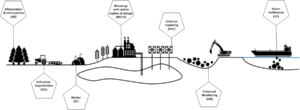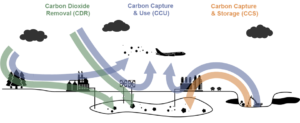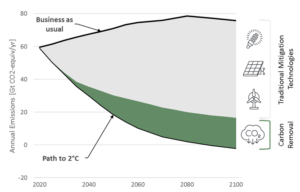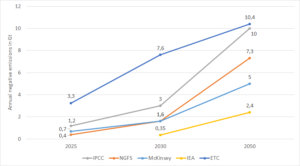Carbon Dioxide Removal (CDR) is the process of capturing CO2 or other greenhouse gases from the atmosphere and locking it up in carbon sinks. This reduces the concentration of CO2 or other greenhouse gases in the atmosphere. Various solutions and technologies are already being used on a larger scale, while others are still at an earlier stage of development. The technologies differ from each other, sometimes considerably, in terms of their costs and potentials, but also in terms of their secondary impacts on ecosystems. It is likely that a mix of technologies will prevail depending on the respective availability and socio-economic structures on the ground.
In order to meet global climate goals, avoidance and reduction of emissions has priority. Nevertheless, according to the scenarios of the Intergovernmental Panel on Climate Change (IPCC), the use of CDR solutions must be scaled up drastically in order to achieve the 1.5°C but also the 2°C target.
The private sector plays an important role here, provided that corporate climate targets envision the use of carbon removal solutions. Companies can use CDR certificates, for example, to neutralise emissions from their products, services or supply chain. If companies follow high quality climate standards (e.g. the Science Based Target Initiative – SBTi), they have even committed to do so. At the same time, the flow of capital into the carbon removal sector contributes to large-scale cost reductions that make large-scale deployment to achieve global climate goals possible in the first place.
The integrity of the CDR projects and embedding them into a corporate climate strategy is imperative for the successful engagement of companies. This is the only way to ensure a sustainable contribution to meeting your own climate targets.
The selection of CDR projects that fit the climate strategy is a complex task in view of the technological diversity and the qualitative differences. We are happy to support you with our expertise.
Our
services
Carbon Dioxide Removal Strategy
We support you in the sustainable implementation of CDR solutions in your business model and your company.
Climate-neutral products and services
Use our expertise to neutralise the climate footprint of your products and services according to the highest standards.
Portfolio and procurement strategy
Together with you and your stakeholders, we develop a customised portfolio with CDR solutions. We advise you on procurement strategies and forecast your costs.
Transformation of compensation portfolios
Increase the integrity of your climate strategy! With us you identify the optimal transformation path to transform your existing offset portfolio into a state-of-the-art neutralisation portfolio.
Market access
Benefit from our access to various project developers and global marketplaces for CDR certificates. We handle all transactions, monitor decommissioning and prepare your reporting.
Get in touch.
+49 176 88 31 70 54
FAQs
Does carboneer also offer greenhouse gas accounting services?
Together with our partners, we also provide accounting services for internal and external greenhouse gas emissions (Scope 1-3) for selected clients.
What does climate neutrality or net-zero mean in companies?
Companies, processes and products are climate-neutral if their greenhouse gas emissions have been accounted for using recognized standards and offset through climate protection projects. After avoiding and reducing emissions, offsetting residual emissions is an integral part of a high-quality corporate climate strategy. Residual emissions might remain because CO2-free solutions are not yet available for all energy sources, products, processes or services.
What are Science Based Targets?
Science Based Targets (SBT) are a scientific approach and criteria for defining stringent climate protection measures and provide a clearly-defined pathway for companies and financial institutions to reduce greenhouse gas (GHG) emissions, helping prevent the worst impacts of climate change and future-proof business growth.
Targets are considered ‘science-based’ if they are in line with what the latest climate science deems necessary to meet the goals of the Paris Agreement – limiting global warming to well-below 2°C above pre-industrial levels and pursuing efforts to limit warming to 1.5°C.
What is the Science Based Targets Initiative?
As a joint initiative of CDP, UNGC, WRI and WWF, the Science Based Targets Initiative (SBTi) establishes the methodologies and criteria for effective corporate climate action. The SBTi also validates corporate climate targets and since 2015 more than 2,500 companies have joined the initiative to set a science-based climate target.
What is the difference between compliance and voluntary emissions markets?
Compliance emissions markets are organised by states or regions. Certain companies are legally obliged to participate in these markets (for example EU ETS or nEHS).
In voluntary emissions markets, companies can purchase CO2 certificates and use them to achieve their climate targets.
What does offsetting mean?
Offsetting refers to the balancing of corporate CO2 emissions through the purchase of CO2 credits on voluntary emissions markets or from project developers. The CO2 credits can come from offset or neutralisation projects.
What is the difference between compensation and neutralisation?
A compensation project avoids the emission of CO2 compared to a baseline scenario. The project can issue a corresponding number of compensation certificates. The definition of the baseline scenario and the corresponding climate impact of the project are often difficult to determine.
In contrast, projects that remove CO2 or other greenhouse gases from the atmosphere can generate CDR certificates. The use of these CDR certificates to offset corporate greenhouse gas emissions is known as neutralisation.
What is a carbon credit?
A carbon credit represents the certified reduction of one tonne of carbon dioxide equivalent or the removal of one tonne of carbon dioxide equivalent (tCO2e) from the atmosphere.
What are the requirements for carbon credits?
Different organizations (e.g. Puro, Gold Standard, Verra) define different strict quality criteria for carbon credits.Generally, offset and neutralisation projects must:
- Meet and follow international standards (Certification)
- Demonstrate credible and verifiable emission reductions or removals of greenhouse gases from the atmosphere (Real Projects)
- Certification and verification of data must be carried out by independent third parties (Independent Verification)
- The emission reduction or removal of greenhouse gases from the atmosphere must not have occurred without the project activity (Additionality)
- Each compensation or CDR certificate may only be cancelled once (no double counting)
- All project impacts must be transparent and recorded in a public register (Traceability)
What is Carbon Dioxde Removal?
Carbon Removal, also Carbon Dioxide Removal (CDR), is the process of capturing CO2 from the atmosphere and trapping it in carbon sinks. Some techniques are already being used on a small scale, while others are still in the early stages of development.
Many different natural and technological solutions for taking greenhouse gases out of the atmosphere exist. Those negative emission technologies differ in terms of the final reservoirs of CO2, the durability of storage outside the atmosphere, their cost structure, and their environmental and socio-economic side effects.

What is the difference between CDR, CCS and CCU?
Carbon Capture and Storage (CCS) or Carbon Capture and Utilisation (CCU) should not be confused with CDR. Only CDR causes permanent removals from the atmosphere and thus contributes to decreasing CO2 concentrations.
CCS refers to a process in which CO2 produced by the utilisation of fossil resources is captured and trapped underground. CCU uses CO2 to produce short-lived products such as plastics or synthetic fuels. Sooner or later, the CO2 ends up back in the atmosphere.

However, some carbon removal solutions, such as direct air capture or bioenergy with carbon capture and storage, can use similar components and infrastructure as CCS. In particular, for transport and long-term geological storage
Is CDR needed for global climate targets?
In order to meet the global climate goals, the avoidance and reduction of emissions is a priority. However, the technologies needed for this are not yet available in the medium term, so according to the Intergovernmental Panel on Climate Change (IPCC), large-scale removal of CO2 from the atmosphere is also necessary. Regardless of whether the global community wants to limit global warming to 1.5 °C or 2 °C, the use of CDR technologies is inevitable.

How many tonnes of greenhouse gases must be removed from the atmosphere to achieve global climate targets?
The magnitude of the necessary removals is expected to range between 4.5 and 15 gigatonnes of CO2 per year from 2030 until the end of the century. This corresponds to about 15 to 50 per cent of today’s annual global anthropogenic CO2 emissions. The order of magnitude depends on the rate of greenhouse gas conservation and reduction in all sectors.

Why should your company use CDR certificates or projects?
For credible climate targets and to avoid greenwashing accusations, certificates from high-quality CDR or compensation projects are preferable to other offsets. Ambitious climate strategies and standards, such as the Science Based Targets Initiative (SBTi), call for the neutralisation of emissions and thus the use of CDR certificates or projects.
What are the prices for a CDR certificate?
The prices for CDR certificates vary greatly depending on the technology and can range from 30 to more than 500 EUR/tonne. In general, the higher the price, the more long-term and climate-effective the removal of CO2 from the atmosphere.
What is a CDR portfolio?
A CDR portfolio consists of certificates from different CDR projects. Through this diversification, a CDR portfolio can reduce price and default risks and thus ensures a low-risk implementation of a corporate climate and carbon removal strategy.
How can I be sure that the selected projects actually remove greenhouse gases from the atmosphere?
In order to generate CDR certificates, projects must follow certain technicall standards. The compliance of CDR certificate providers with these standards is verified by external service providers and platforms.
carboneer works with high-quality CDR projects and marketplaces. Independent verifiers ensure that CDR certificates are only issued for greenhouse gases actually removed from the atmosphere. Avoiding double counting of CDR certificates is ensured by the terms of use at the marketplaces and the project verifications.
